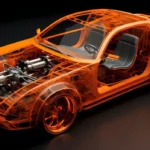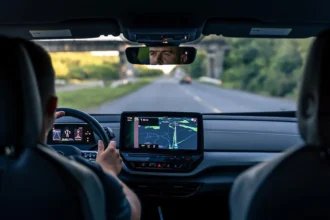Are You Aware of the Life-Saving Technologies in Your Car?
Cars have evolved dramatically in recent years, and it’s not just about speed, luxury, or design anymore—safety has become a major focus. With the growing number of advanced driver assistance systems (ADAS), car safety technology is no longer a luxury but a necessity. But do you know which car safety tech features are must-haves in 2024?
In this article, we’ll break down the essential car safety tech you need to know about, explore how these technologies work, and why they are critical to your protection on the road.
Why Car Safety Tech Matters
Every year, thousands of accidents happen across the U.S. Many of these could be prevented or minimized with the right safety features in place. Car safety technology plays a pivotal role in reducing road injuries and fatalities by alerting drivers to potential hazards, preventing crashes, and assisting in managing dangerous situations.
If you’re looking to buy a new car or simply want to stay informed, knowing about the best car safety tech features is crucial. Let’s dive in!
1. Automatic Emergency Braking (AEB)
Automatic Emergency Braking (AEB) is a must-have safety feature designed to prevent or reduce the severity of collisions. If your car detects an imminent collision, AEB automatically applies the brakes to avoid or lessen the impact.
How It Works:
AEB uses radar, cameras, or both to monitor the road ahead. If a sudden stop or obstacle is detected, the system will send a warning to the driver. If no action is taken, AEB will automatically engage the brakes.
Why It’s Important:
According to the Insurance Institute for Highway Safety (IIHS), cars with AEB have significantly lower crash rates. This feature can be particularly helpful in stop-and-go traffic, where rear-end collisions are common.
Primary Keyword Used: Car Safety Tech
2. Lane Departure Warning (LDW) and Lane Keeping Assist (LKA)
We’ve all had moments when we drift out of our lane unintentionally. Lane Departure Warning and Lane Keeping Assist are designed to prevent this, keeping drivers safely in their lane and avoiding potential collisions.
How It Works:
- Lane Departure Warning (LDW): This feature alerts the driver if the car unintentionally drifts out of its lane without the turn signal being activated.
- Lane Keeping Assist (LKA): This technology takes it a step further by gently steering the car back into its lane if it detects a lane departure.
Why It’s Important:
LDW and LKA help reduce accidents caused by distracted or fatigued driving. It’s especially beneficial during long drives or nighttime driving when focus may slip.
Primary Keyword Used: Car Safety Tech
3. Blind Spot Detection (BSD)
Changing lanes can be risky, especially with blind spots that you can’t easily see in your mirrors. Blind Spot Detection (BSD) is designed to alert you when there’s a vehicle in your blind spot.
How It Works:
Using radar sensors, BSD monitors the sides of your car and alerts you with a warning light or sound if a vehicle is detected in your blind spot. In some cars, it may even prevent you from changing lanes if it senses danger.
Why It’s Important:
Blind spots can be deadly, especially in heavy traffic. BSD reduces the likelihood of accidents during lane changes, making it one of the most essential car safety tech features.
Primary Keyword Used: Car Safety Technology
4. Adaptive Cruise Control (ACC)
Unlike traditional cruise control, Adaptive Cruise Control (ACC) automatically adjusts your car’s speed to maintain a safe distance from the vehicle in front of you. This feature is particularly useful on highways and during long commutes.
How It Works:
ACC uses sensors to measure the speed and distance of the car ahead. If traffic slows down, ACC reduces your speed accordingly. When the road clears, it accelerates back to your preset speed.
Why It’s Important:
By automatically adjusting speed, ACC helps prevent rear-end collisions and reduces driver fatigue, making it one of the top car safety tech features for highway driving.
Primary Keyword Used: Car Safety Technology
5. Rearview Camera and Surround-View Systems
Backing out of driveways or parking spots can sometimes be tricky, especially with limited visibility. Rearview cameras and surround-view systems make this process safer by providing a clear view of the area behind your car.
How It Works:
A rearview camera displays a live feed of what’s behind your vehicle when you shift into reverse. Surround-view systems take it further by offering a 360-degree view using multiple cameras around the car.
Why It’s Important:
Rearview cameras reduce the risk of hitting pedestrians, cyclists, or objects that may be hard to see from the driver’s seat. They are particularly useful in preventing parking lot accidents.
Primary Keyword Used: Car Safety Features
6. Pedestrian Detection
Pedestrian accidents are among the most dangerous types of crashes. Pedestrian Detection systems can help prevent these incidents by recognizing people in or near the road and alerting the driver or even applying the brakes if necessary.
How It Works:
Pedestrian Detection uses cameras and sensors to identify people on the road. When a pedestrian is detected, the system warns the driver. If the driver doesn’t respond in time, the car can automatically brake.
Why It’s Important:
This feature is particularly useful in urban areas with heavy foot traffic. Pedestrian Detection is one of the most valuable features in modern car safety tech, especially for drivers in busy cities.
Primary Keyword Used: Car Safety Tech
7. Electronic Stability Control (ESC)
Electronic Stability Control (ESC) is a critical safety feature that helps drivers maintain control of their car during extreme steering maneuvers. Whether you’re taking a sharp curve or driving on slick roads, ESC can be a lifesaver.
How It Works:
ESC detects when your car is starting to skid or lose control. It automatically applies the brakes to individual wheels and reduces engine power to help you regain control.
Why It’s Important:
ESC can prevent rollover accidents and is especially helpful in slippery conditions like rain or snow. It has been proven to reduce the risk of fatal single-vehicle crashes.
Primary Keyword Used: Car Safety Tech
8. Forward Collision Warning (FCW)
Forward Collision Warning is an advanced safety feature that warns drivers of an impending crash with the vehicle in front of them.
How It Works:
FCW uses sensors to monitor the distance and speed of the vehicle ahead. If it detects that you’re approaching too quickly, it provides an audible and visual warning, giving you time to react.
Why It’s Important:
This feature can be a real lifesaver in sudden stop-and-go traffic, where rear-end collisions are common. It’s one of the most essential car safety technologies for preventing accidents caused by inattentive driving.
Must-Have Car Safety Tech Comparison Table
| Car Safety Feature | Function | Benefit |
|---|---|---|
| Automatic Emergency Braking | Brakes automatically to prevent collisions | Reduces crash severity |
| Lane Keeping Assist | Gently steers car back into lane | Prevents unintended lane drifting |
| Blind Spot Detection | Alerts to vehicles in blind spots | Avoids accidents during lane changes |
| Adaptive Cruise Control | Adjusts speed to maintain safe distance | Reduces driver fatigue on highways |
| Rearview Camera | Displays area behind the car while reversing | Helps prevent backing up into objects |
| Pedestrian Detection | Recognizes pedestrians and alerts the driver | Reduces pedestrian-related accidents |
| Electronic Stability Control | Maintains control during extreme maneuvers | Prevents skidding and rollovers |
| Forward Collision Warning | Warns of potential collisions with the vehicle ahead | Prevents rear-end crashes |

Frequently Asked Questions (FAQs)
Q1: What is the most important car safety tech feature?
A: It’s hard to single out one feature, but Automatic Emergency Braking (AEB) and Electronic Stability Control (ESC) are considered life-saving technologies due to their ability to prevent or reduce the severity of accidents.
Q2: Are car safety features worth the extra cost?
A: Absolutely. The cost of adding safety features is minimal compared to the potential cost of an accident. Many features, like AEB and Blind Spot Detection, can save lives, which is priceless.
Q3: Can I add these safety features to an older car?
A: Some car safety technologies can be added to older vehicles, like rearview cameras or blind-spot mirrors. However, more advanced systems like Adaptive Cruise Control or Lane Keeping Assist typically require integrated technology that is built into modern vehicles.
Q4: Are car safety features available in all cars?
A: Many car safety tech features are now standard in new vehicles, especially in higher trims or luxury models. Some are even required by law, like rearview cameras in the U.S.
Final Thoughts
Investing in the latest car safety tech is more than just adding bells and whistles—it’s about protecting yourself and others on the road. With features like Automatic Emergency Braking, Blind Spot Detection, and Adaptive Cruise Control, driving has never been safer. As you consider your next car, make sure these must-have car safety technologies are on your list.









